Some tools are vital, while others are ‘nice-to-haves’, so we have taken a look at the essential tools that should be in every garden shed. None are cheap and most are at the higher price end, but in almost every case you’ll only need to buy these once in your lifetime, so you might as well enjoy using them.
Garden Beds
Lets start with ground preparation – in the flower or veggie beds.
#1. Forks and Spades
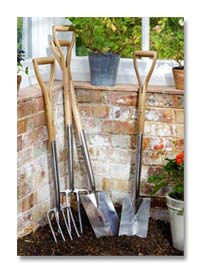 OK, I’m cheating already as its not possible to decide if a fork or a spade is more important – frankly you really need one of each. A strong and well balanced tool will minimise effort and last you for years providing that you look after it. (e.g. wipe it off with an oily cloth after use and keep it in the dry)
OK, I’m cheating already as its not possible to decide if a fork or a spade is more important – frankly you really need one of each. A strong and well balanced tool will minimise effort and last you for years providing that you look after it. (e.g. wipe it off with an oily cloth after use and keep it in the dry)
Ash has been the wood of choice for handles ever since Capability Brown was an apprentice and stainless steel is vital for strength, while also providing a sharp spade edge or fork points. Ergonomic balance and a comfortable ‘D’ grip handle are also key features to look out for.
Then there’s the width of the head (or tines).
Digging spades and forks are broader, collect more soil and therefore cover more ground quickly.
Border spades and forks are narrower and better for digging in amongst planted areas – they also lift less soil on each movement so are better for those with less strength.
I prefer a border spade/fork as they require less effort overall and you can therefore work faster and more accurately. Its not a male/female thing, its about choosing the right tool for your capabilities and needs.
Brits make excellent garden tools and this selection from Burgon & Ball of Sheffield UK are amongst the best you’ll find.
#2. Rake
Having turned the soil to loosen it and get some air in, you really need to smooth it all out before planting. A good rake is the only way to do this while also gently removing debris and stones.
Garden rakes were originally made only from wood but the industrial revolution made nails cheap so they soon became the preferred material for tines. Today the 150 year old design of the Nail Rake is still commonly available and just as effective as it ever was.
The Bow Rake made its debut in the late 19th century, promising a better balance and spread of energy across the broad head of tines. It's a more elegant design but it comes down to a matter of personal preference – or maybe aesthetics as to which one is better.
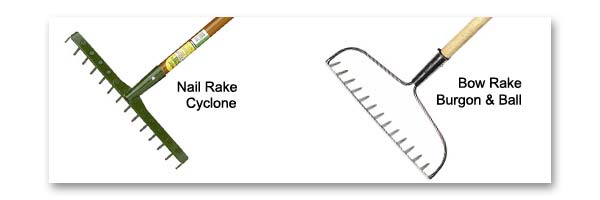
#3. Dibber
When it comes to planting, especially bulbs and seeds I’ve seen many gardeners flip their hand trowel over and use the handle to make a planting hole, while others are happy to use their fingers.
I wouldn’t even start planting without my age old dibber passed down to me from my grandpa. Its one of those tools I use almost unconsciously but one that is invaluable for making firm sided planting holes of varying depths.
Frankly, if you have a good woodworkers lathe you can make one yourself, needing just a tapered piece of dowling to do the job.
There are some extremely fancy ones on the market and the Sophie Conran designs from the UK could almost double as good mantle-piece ornaments, but we recommend the Dibblet from Burgon and Ball that has easy to see measuring bands down the shaft. And at less than $20 its also great value.
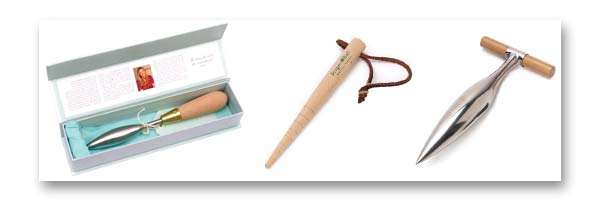
Pruning
Every garden will have some trees or shrubs and some of those may be kept trimmed as hedges. So pruning and clipping will be regular tasks to keep your garden looking sharp.
#4. Secateurs
When you think of garden tools, a pair of secateurs has to be one of the most prevalent. But not everyone realises that if you buy right you’ll only need to buy once in your lifetime. Judging by the number of secateurs you’ll see in Bunnings priced under $20, it seems there is a big market for cheapies . . . big because you need a new pair every six months.
The Europeans make the best secateurs with Burgon & Ball of the UK and Wolf Garten of Germany up there with ranges of top quality tools.
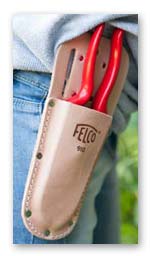 But if you look at the belt holsters of workers in Botanic Gardens anywhere in the world you’ll only see one brand – and that's Felco of Switzerland.
But if you look at the belt holsters of workers in Botanic Gardens anywhere in the world you’ll only see one brand – and that's Felco of Switzerland.
Felco pioneered the use of aluminium handles combined with hardened steel blades and a mechanism that can be easily dismantled to clean and re-sharpen. The Felco 2 is still popular today almost fifty years later (I know I have a 25 year old pair), but we recommend the Felco 7 that also features a rotating handle which is easier on the fingers, especially when you have a lot of pruning to do.
Sap grooves, rubber buffers, easy reach locking catch and replaceable blades and springs are important features to look for but ergonomic balance in the hand is the key quality and Felco are absolute masters of that particular art.

#5. Pruning Saw
Again it's the Europeans that make the best pruning saws. But not any saw format will do for pruning where the saw needs to be quite rigid and open ended (e.g. a bow saw is next to useless in these conditions). The blade also needs to be gently curved with blades set to cut on the pull.
There are many pruning saws on the market that come with a sheath that can be worn on the belt, but I prefer a folding design that keeps the blade protected and allows the tool to be slipped into a pocket when not in use.
Bahco have been making world class steel in Sweden for centuries and are one of the world’s top manufacturers of saw blades, especially ‘hardpoint’ blades which hold their edge longer. This 369-HP has a 190mm blade, safety locking catch and very comfortable soft-grip handle. I know, I’ve had one for five years and absolutely love it.

#6. Hand Lopper
When the wood is too large for secateurs then you’ll need a good pair of loppers. These come in two forms #1. Anvil which are best for old, or dead wood and #2. Bypass which are best for green wood (and perhaps the most versatile).
But with the extra strength often comes extra weight and extended periods of work can get hard on the arms - unless you have anodised aluminium handles that are strong enough to handle the leverage required to cut thicker wood. This requires good design and materials and this ‘Europhile’ reviewer again can’t go past the Wolf Garten telescopic bypass loppers as the best choice for all round garden performance.
The telescopic arms extend from 650 to 900mm giving you very valuable extra reach that can save getting the ladders out. The longer handles also exert more leverage on the cutting head, though when fully extended you’ll need longish arms to fully open the blades.
Non-stick coatings and sap groove on the cutting blades help keep them functioning smoothly while the Powercut mechanism can increase the cutting force by up to 4 times, allowing a cutting capacity of up to 50mm.
Felco of Switzerland, Burgon & Ball of UK, Bahco of Sweden and Kamaki of Japan also make very good loppers but we have chosen the Wolf Powercut RR900T Telescopic Loppers as our ultimate recommendation and a delight to use. (Editor's note - Kamaki have recently stopped trading - that's a pity)

#7. Hedge Shears
Unless you have a power hedge trimmer, a good pair of hand shears are absolutely vital to keep your hedges looking smart. Again you’ll find any number of cheapie knock-offs in the hardware stores but the sheer pleasure of using a well designed and manufactured pair is enough reason to shell out a few more dollars.
You’ll find formats with #1. Straight Blades and #2. Wavy Edged Blades.
Wavy Edge blades are designed to help catch the foliage in the blades and increase cutting efficiency. This may be the case but you’ll need to get them professionally sharpened so we don’t think they are necessarily the best buy.
Straight edged blades are very versatile and are good for covering larger areas quickly. But if you are planning to trim your hedge plants into fancy shapes (topiary) then you’ll need a different format which has shorter blades with narrower tips for increased accuracy. The really keen topiarist will even use a pair of old fashioned looking, single handed sheep shears for the ultimate in precision – but that's another story.
Good quality hedge shears are another tool that will probably be used for prolonged periods so ergonomic balance is vital to minimise fatigue. You’ll also need comfortable handles too with good buffers to avoid cracking your knuckles together on every clip which can encourage undue cursing. These Wolf straight bladed, teflon coated HS-TL shears are excellent performers.

Lawns
As my kids have grown and flown the nest so my lawn has changed from being a mini-sporting field to providing an important contrast between shrubs and flower borders while using the curving edges to accentuate the flowing lines of the garden design.
As such the lawn is an important element of most gardens and can be the source of a lot of hard work too – unless you search out some innovative tools of course.
#8. Aerator Sandals
A surprise contender for most valuable tool, Lawn Aerator Sandals are absurdly simple in design while saving vast amounts of energy getting air into a compacted lawn. And not everyone knows that air is as important a component of soil as moisture is for all plant roots to perform efficiently.
There are two other options - #1. A spiked lawn roller is expensive and difficult to find unless you are a greenkeeper. #2. A garden fork inserted with effort hundreds or even thousands of times over a large lawn. Ouch, no thanks.
Instead you can strap on a simple plastic base with a bunch of nails protruding through the sole and take a gentle walk across your lawn. It is a good idea to water the lawn first to ensure the soil is damp enabling the spikes to enter and extract easily. But that's all there is to it to keep your lawn in top condition around twice a year, and you’ll be glad you’ve got a pair of Lawn Aerator Sandals, even if they’re not exactly a fashion statement.
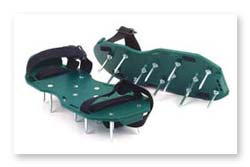
#9. Scarifying Roller
Most lawns will develop a thatch over time, especially shaded areas or lawns that have plenty of fescue grasses in them. A thatch is made up predominantly of mosses but also includes debris and surface roots which create an increasingly impermeable layer, starving your lawn of moisture and air.
The solution is to de-thatch which involves a thorough combing of the lawn surface, rather like a stiff brushing of your hair.
You can do this with a similar implement to a hairbrush, being a flexible tined wire rake, but this needs plenty of effort and a big lawn will exhaust even the fittest gardener.
Scarifying rakes feature firm finger blades that will cut through the thatch more aggressively, pulling moss and debris to the surface and opening up the topmost layer of soil to allow nutrients, water and air down into the grass roots.
The luxury version of a Scarifying rake has wheels on either side and one-way-hinged tines to allow them to lift as you push away and dig in as you pull. Frankly there’s no competition between the non-wheeled and the wheeled versions as it maintains a constant height while raking thereby saving huge amounts of energy.
This scarifying roller rake from Wolf Garten of Germany has a multi-change click on handle (sold separately) that can also be used with a wide range of other tool heads made by Wolf.
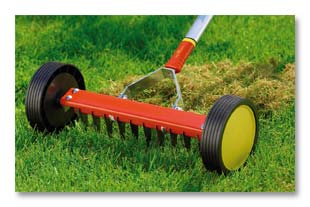
#10. Border Shears
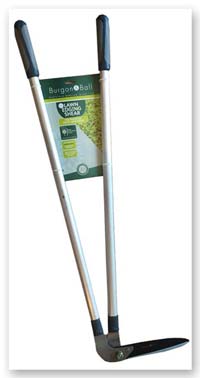 Now when it comes to neat lawn edges many Aussies will swear by their power strimmer, that's if they don’t mind lugging a noisy and heavy, petrol guzzling tool around their garden.
Now when it comes to neat lawn edges many Aussies will swear by their power strimmer, that's if they don’t mind lugging a noisy and heavy, petrol guzzling tool around their garden.
Having spent my early years in the UK, I was introduced at a young age to the very effective vertically bladed, long handled, lawn border edging shears. In fact when my dad did the mowing he handed me the border shears to earn my pocket money – which I didn’t mind as it wasn’t a hard job to do at all.
These aren’t the only way to crisp lawn edges though, as the Half Moon Edger is also favoured by many traditionalists, especially where the lawn edge is level with the path alongside, though I find it needs a bit more effort than the border shears.
Burgon & Ball of the UK have worked for years with the RHS to create tools that meet the highest standards (technically and culturally) and as such we can’t go past these shears that feature aluminium shafts with soft grip handles and high carbon steel cutting blades.
Not the cheapest on the market, they will however be a pleasure to use and last you until you get your grandchildren to help you keep your lawns looking great.
So there it is, the GardensOnline recommended top ten garden tools.
Buying carefully will serve you well, often over many decades, providing that you continue to look after your tools.
After use all cutting blades should be wiped over with meths first to kill off any disease then followed up with an oily cloth.
And saw blades need a stiff brushing to get residue and debris out from between the teeth – followed again by a meths wipe and a final oily cloth wipe.
Buy well - buy once.